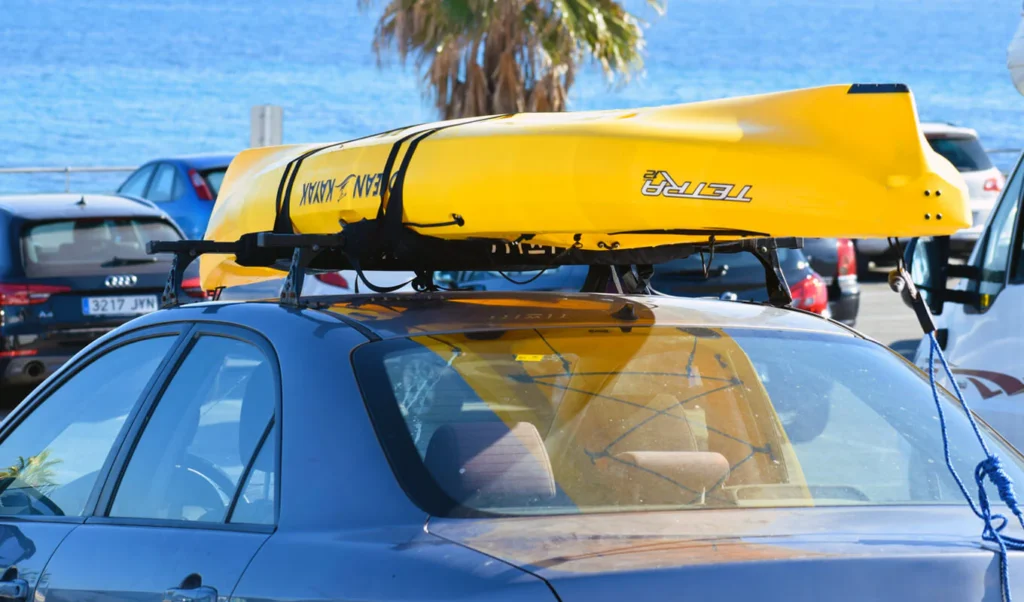How to transport a kayak—it’s one of the first questions every new paddler asks, and surprisingly, it’s one of the trickiest to answer. Whether you’ve just bought your first kayak or you’re planning a weekend on the water, figuring out how to move that long, awkward boat from your driveway to the shoreline can feel like a puzzle. Do you need a roof rack? What if you drive a small car? Can you do it alone, or will you always need a second person? The good news is, there are solutions for just about every situation—and this guide will walk you through them all.
We’re not here to throw technical jargon at you or assume you’ve got top-tier gear. This guide is built for real people with real questions. You’ll learn how to choose the right transport method based on your vehicle, budget, and lifestyle. We’ll also share easy-to-follow steps for loading, securing, and unloading your kayak safely, plus smart gear recommendations and common mistakes to avoid. Whether you’re heading out for a peaceful paddle at the lake or prepping for your next big adventure, this is everything you need to get your kayak there safely, stress-free, and without damaging your gear (or your car).
Choosing the Right Method for Transporting Your Kayak
When it comes to how to transport a kayak, there’s no one-size-fits-all answer. The best method depends on your vehicle, the type of kayak you own, and how often you plan to use it. Whether you drive a small sedan, a rugged SUV, or a pickup truck, there’s a transport solution out there that’ll fit your needs—and your budget.
No Roof Rack? No Problem.
If your car doesn’t have a built-in roof rack, don’t worry—you’re not stuck. One of the simplest and most affordable methods involves using foam blocks or pool noodles combined with high-quality cam straps or ratchet tie-downs. These cushion your kayak and help hold it in place on top of your car. It’s a great option for occasional trips and short distances, especially for beginners.
Got a Roof Rack? Upgrade with Attachments
If your vehicle already has a factory or aftermarket roof rack, you’re ahead of the game. Adding kayak carriers like J-cradles, saddles, or stackers can make loading and securing your kayak much easier and safer. J-cradles hold the kayak on its side to save space, while saddles offer more surface support. These are ideal for regular paddlers who want fast, secure setups.
Pickup Truck Owner? Use the Bed or Extend It
Trucks give you more flexibility. You can lay the kayak flat in the bed with the tailgate down or use a bed extender for longer boats. Just make sure to secure the front and back of the kayak with straps, and always use a red flag if there’s an overhang (which is legally required in many areas).
Transporting Multiple Kayaks or Larger Loads?
For families or paddling groups, using a kayak trailer is often the best option. Trailers can hold multiple boats and keep the roof of your vehicle free for extra gear. They’re especially helpful for heavier kayaks or long-distance trips. While they do require a hitch and sometimes registration, they save time and reduce lifting strain.
No matter your setup, the key is choosing a method that fits your lifestyle, keeps your kayak secure, and protects your vehicle. Up next, we’ll walk you through exactly how to load, strap, and unload your kayak safely—even if you’re doing it solo.
Step-by-Step Guide: Loading, Securing & Unloading a Kayak
Transporting your kayak safely starts with knowing exactly how to load and secure it. Getting these steps right protects your gear, your vehicle, and other drivers on the road. Don’t worry if you’re new to this—these tips are simple and designed to work whether you’re alone or with a friend.
Step 1: Inspect Before You Load
Before you lift your kayak, take a quick look for any cracks, loose parts, or gear inside that could shift during transport. Make sure hatches and compartments are closed tightly, and remove anything that might fall out or get damaged.
Step 2: Loading Your Kayak
If you have help, loading is easier: lift the kayak from the middle and gently set it on your roof rack or foam blocks. If you’re solo, try this trick: place the kayak near your car sideways with the cockpit facing up. Lift one end onto the roof, then walk around and slide the other end up carefully. For taller vehicles, a lift-assist strap or a roof ladder can make this easier and reduce strain on your back.
Step 3: Securing the Kayak
Securing your kayak properly is key to a safe trip. Start by placing your kayak evenly on the rack or blocks. Use cam straps or ratchet straps to tie down the kayak at least in two places: one near the front (bow) and one near the back (stern). Avoid tightening too much to prevent warping the hull, but make sure the kayak won’t shift or bounce.
Don’t forget to secure the kayak to your car itself—many people overlook this and rely only on the roof rack. Using bow and stern lines attached to your vehicle’s bumper or tow hooks adds extra stability, especially at higher speeds or in windy conditions.
Step 4: Final Safety Check
Before you hit the road, double-check all straps and knots. Give your kayak a gentle shake—if it moves, tighten your straps. Attach a red flag to the kayak’s tail if it extends beyond your vehicle’s rear, as required by law in many states.
Step 5: Driving Tips with a Kayak
Drive a bit slower than usual, especially on highways. Avoid sudden stops or sharp turns, and be mindful of low clearances like parking garages or tree branches. If you’re traveling long distances, stop periodically to check your kayak’s security.
Step 6: Unloading Your Kayak
When you arrive, unload with the same care you took loading it. If you’re alone, use the same lifting technique—lift one end first, then slide the kayak down gently. Avoid dropping it or dragging it on rough surfaces to prevent scratches or damage.
By following these simple steps, you’ll keep your kayak safe and your transport stress-free. Next, we’ll dive into the must-have gear that makes this process even easier and more secure.
Equipment You’ll Need (and How to Use It Right)
Having the right gear makes transporting your kayak much easier, safer, and more comfortable. Whether you’re just starting or looking to upgrade your setup, investing in quality equipment can save you time, protect your kayak, and reduce stress every time you hit the road.
Roof Racks and Kayak Carriers
If your vehicle doesn’t come with a roof rack, adding one is usually the first step. Roof racks provide a sturdy base to hold your kayak during transport. Popular options include crossbars, which run side-to-side across your roof, creating a strong platform for kayak carriers or foam blocks.
For holding the kayak itself, there are a few common carrier styles:
- J-cradles hold your kayak on its side, making it easier to load and allowing space to carry multiple kayaks.
- Saddles support the kayak on its hull, offering excellent stability and protection.
- Stackers let you stack kayaks flat on top of each other, perfect for multiple boats.
Choosing the right carrier depends on your kayak type, how many boats you’re transporting, and your vehicle’s roof rack setup.
Tie-Down Straps and Safety Lines
Secure straps are essential. Look for durable, adjustable cam straps or ratchet straps with rubber-coated hooks to avoid scratching your car. You’ll need at least two straps to hold the kayak down firmly, plus extra bow and stern safety lines attached to your vehicle’s bumpers or tow hooks for added security.
Avoid using bungee cords—they’re not strong enough and can stretch or snap during transport.
Foam Blocks and Pads
If you don’t want to invest in a full roof rack system, foam blocks or pool noodles are budget-friendly options to cushion your kayak on your car’s roof. These blocks prevent scratches and keep the kayak steady, especially when paired with quality straps.
Kayak Carts and Dollies
For easy movement between your car and the water, especially if you have a longer walk or rough terrain, a kayak cart or dolly can be a lifesaver. These wheeled devices let you roll your kayak instead of carrying it, reducing strain on your back and arms.
Covers and Cockpit Seals
Protect your kayak from sun damage and dirt during transport with a kayak cover. Cockpit covers also keep water and debris out if you’re transporting an open cockpit kayak, saving you cleanup time once you reach your destination.
Lift-Assist Systems and Roof Ladders
For taller vehicles like SUVs and vans, lift-assist straps or roof ladders make loading and unloading much easier. They reduce the effort required and help prevent accidents or damage during the process.
Using the right equipment not only protects your kayak and vehicle but also makes every trip more enjoyable. In the next section, we’ll explore real-world tips and common transport challenges to help you avoid mistakes and transport like a pro.
Real-World Scenarios & Tips from the Water
Transporting a kayak isn’t always a straightforward task, especially when real life throws in some curveballs. Whether you’re juggling multiple boats, traveling long distances, or facing unpredictable weather, learning from real paddlers’ experiences can make all the difference.
Transporting Multiple Kayaks? Plan Ahead
Hauling more than one kayak takes extra care. Roof racks with J-cradles or stackers let you carry two or three boats safely, but you’ll need longer straps and more tie-down points. Make sure the weight is evenly distributed and none of the kayaks wobbles during the drive. If your vehicle can’t handle multiple kayaks on the roof, consider a kayak trailer. Trailers keep your boats stable and free up your roof for other gear.
Long-Distance Trips Need Extra Preparation
Driving several hours with a kayak on your roof requires more than just strapping it down. Check your straps before leaving and stop every 50-100 miles to tighten them. Keep an eye on the weather forecast—strong winds can increase drag and put extra strain on your kayak and vehicle. Also, remember to pack a small emergency kit with spare straps, a flashlight, and gloves in case you need to make adjustments on the road.
Handling Wind and Weather
Wind is a common challenge for kayak transport. A gusty day can shake your kayak loose if it isn’t secured well. Always use bow and stern lines in addition to roof straps, and consider driving slower on windy roads. Rain or snow means your kayak will be wet, so double-check your cockpit covers and straps for a secure fit to avoid slippage.
Avoid Common Mistakes
Some mistakes are easy to make but costly to fix. Here’s what paddlers often overlook:
- Using weak or worn straps instead of heavy-duty tie-downs
- Forgetting to secure the kayak to the vehicle’s bumper
- Loading the kayak off-center, causing an imbalance
- Ignoring local laws about kayak overhangs and safety flags
- Rushing the loading process and damaging the kayak or the car roof
Pro Tips from Experienced Kayakers
Many seasoned paddlers recommend practicing loading and securing your kayak at home before your first trip. This reduces frustration and helps you spot any missing gear. Another tip: if you often transport your kayak alone, investing in a roof ladder or lift-assist strap will make a huge difference in ease and safety.
By understanding these real-world scenarios and applying simple, practical tips, you’ll save time, avoid headaches, and keep your kayak—and everyone on the road—safe. Ready for some quick answers? Let’s jump into the most frequently asked questions about transporting kayaks.
FAQs: Answering the Most Common Kayak Transport Questions
Transporting a kayak can bring up a lot of questions, especially if you’re new to paddling or trying out new methods. To help you out, here are some of the most common concerns and clear answers to make your next trip easier and safer.
Can I transport a kayak without a roof rack?
Yes! You don’t always need a roof rack to move your kayak. Using foam blocks or pool noodles as padding and strong tie-down straps can do the trick for short trips. Just make sure your kayak is centered, secure, and won’t slide around. This method works best for lighter kayaks and smaller vehicles but isn’t ideal for long distances or frequent transport.
How do I secure a kayak on my car properly?
The key is to use at least two strong straps to hold the kayak down, ideally one near the bow and one near the stern. Don’t forget the bow and stern safety lines attached to your car’s bumper or tow hooks—they provide extra stability. Make sure the kayak sits evenly on your roof rack or foam blocks, and avoid overtightening straps to prevent damaging your kayak.
What’s the best way to carry a kayak alone?
Carrying a kayak solo can feel tricky, but with the right technique, it’s doable. Use a lift-assist strap or roof ladder to reduce the height and effort of lifting. When loading, place one end of the kayak on the roof first, then walk around to lift the other end into place. Practice this a few times at home to build confidence and avoid strain.
Is it legal for a kayak to stick out from my vehicle?
Yes, but rules vary depending on where you live. Most places require you to mark any kayak overhang with a red flag to warn other drivers. Some states limit how far a kayak can extend beyond the car, usually around 4 feet. It’s a good idea to check your local traffic laws before hitting the road to avoid fines and keep everyone safe.
What’s the cheapest way to transport a kayak?
If you’re on a tight budget, foam blocks combined with cam straps or strong ratchet straps are the most affordable way to transport your kayak. Pool noodles cut in half work well as padding, and you can often find straps at a reasonable price online or at outdoor stores. While this method isn’t as convenient as a full roof rack setup, it’s perfect for occasional trips.
In Conclusion: Mastering How to Transport a Kayak with Confidence
Learning how to transport a kayak safely and easily is one of the most important skills for any paddler, whether you’re a beginner or have years on the water. With the right equipment, a few smart techniques, and some practice, moving your kayak becomes second nature. From choosing the best transport method for your vehicle to securing your boat with straps and safety lines, every step matters to protect your kayak, your car, and everyone on the road.
Remember, transporting your kayak doesn’t have to be stressful or complicated. Taking the time to prepare, invest in quality gear, and follow simple safety tips will make every trip smoother and more enjoyable. So next time you’re ready to hit the water, you can focus on the fun ahead, knowing your kayak will get there safe and sound. Happy paddling!



